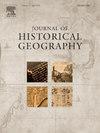投影世界:1900-1920 年比利时投影灯的中介地理学
IF 1.3
2区 历史学
Q2 GEOGRAPHY
引用次数: 0
摘要
本文研究了二十世纪初比利时观众通过投影灯笼这一多模式大众媒体所接触到的虚拟世界。与以往的研究不同,我们从研究少量投影幻灯片对单一地点的视觉呈现,转向研究投影灯媒介所带来的虚拟世界。为了实现这一概述,我们制作并分析了一个数据库,其中包含安特卫普和布鲁塞尔报纸在三个样本时期(1902-1904、1914-1918 和 1922-1924)发表的 5673 次独特的灯笼讲座的公告和评论。在远距离阅读数据库和近距离阅读个别公告之间,我们描绘了比利时这一多模式大众传媒的虚拟世界:全球变得可见的部分--无论是正面还是负面的投射光线--以及仍然曝光不足的部分。我们发现,在这个虚拟世界中,比利时殖民地刚果相对较近,而访问南美洲几乎是不可能的。以往的研究强调对遥远的异国情调的表现,而我们的研究表明,观众最常使用投影灯笼在自己的国家旅行。通过分析虚拟地理的多个尺度--大陆、国家和城市--我们展示了比利时观众是如何通过特定媒体的镜头来体验世界的,揭示了技术、媒体和地理想象力之间复杂的相互作用。本文章由计算机程序翻译,如有差异,请以英文原文为准。
Projecting the world: The mediated geography of the projection lantern in Belgium c.1900-c.1920
This article studies the virtual world(s) that Belgian audiences encountered through the multimodal mass medium of the projection lantern in the early twentieth century. In contrast to previous work, we move from studying the visual representation of a single place in a small number of projection slides to examining the virtual world(s) that the lantern medium enabled. To achieve this overview, we produce and analyze a database of announcements and reviews of 5673 unique lectures lantern lectures published in Antwerp and Brussels newspapers in three sample periods (1902–1904, 1914–1918, and 1922–1924). Oscillating between distant reading the database and close reading individual announcements, we chart the virtual world(s) of this multimodal mass medium in Belgium: the parts of the globe that became visible – be it in a positive or negative projection light – and the parts that remained underexposed. We show that in this virtual world, the Belgian colony of Congo was relatively close, while it was almost impossible to visit South America. While previous research has underlined the representation of far-away and exotic places, our research demonstrates that audiences most prominently used the projection lantern to take trips in their own country. By analyzing the virtual geography on multiple scales —continents, countries, and cities— we show how Belgian audiences experienced the world through the lens of a particular medium, uncovering the complex interplay between technology, media, and geographical imagination.
求助全文
通过发布文献求助,成功后即可免费获取论文全文。
去求助
来源期刊

Journal of Historical Geography
Multiple-
CiteScore
1.50
自引率
10.00%
发文量
53
期刊介绍:
A well-established international quarterly, the Journal of Historical Geography publishes articles on all aspects of historical geography and cognate fields, including environmental history. As well as publishing original research papers of interest to a wide international and interdisciplinary readership, the journal encourages lively discussion of methodological and conceptual issues and debates over new challenges facing researchers in the field. Each issue includes a substantial book review section.
 求助内容:
求助内容: 应助结果提醒方式:
应助结果提醒方式:


